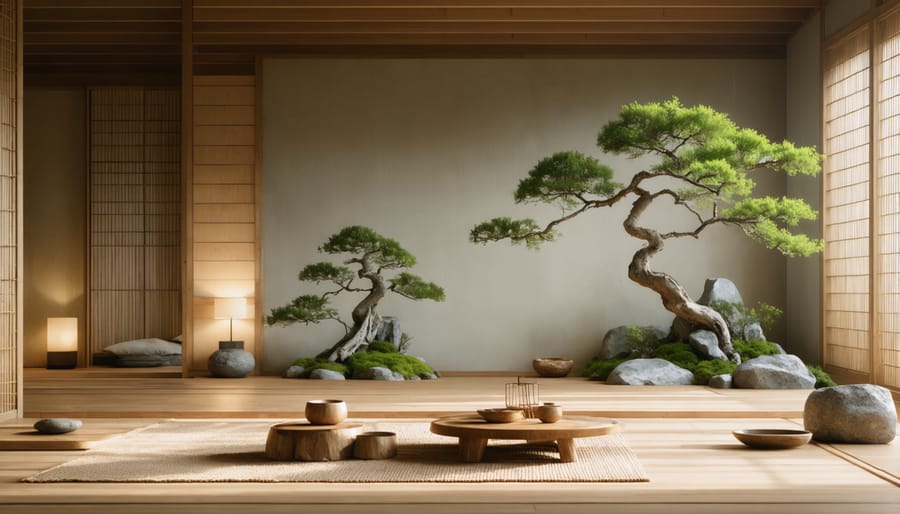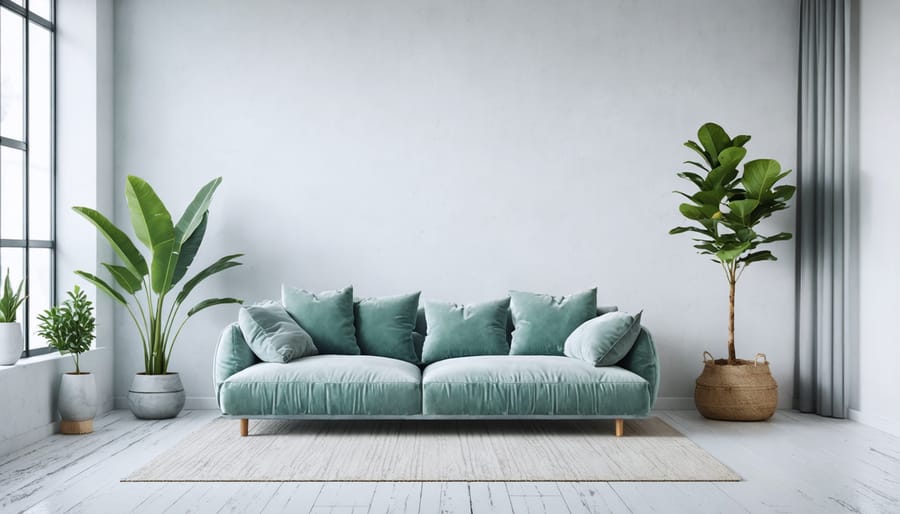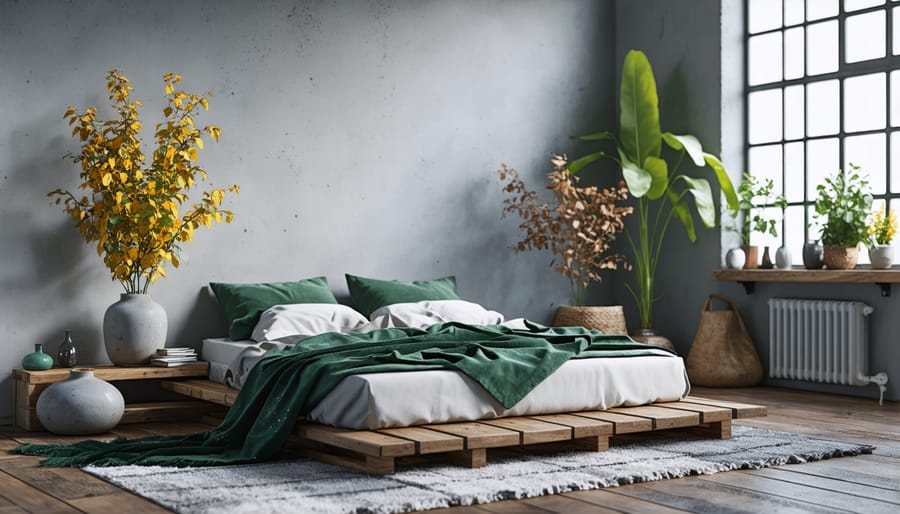
Transform your living space into a harmonious sanctuary by embracing the five essential Japanese elements that have shaped Eastern design philosophy for centuries. These fundamental principles – wood, fire, earth, metal, and water – work together to create spaces that radiate tranquility and purpose. Whether you’re redesigning your entire home or simply refreshing a single room, understanding these elements opens up powerful possibilities for authentic Japanese-inspired interiors. From the gentle curves of bamboo furniture to the clean lines of metalwork, each element contributes to a deeper sense of balance and connection with nature. Modern designers increasingly turn to these timeless principles to create spaces that feel both grounded and sophisticated, proving that ancient Japanese wisdom remains remarkably relevant in contemporary interior design.

In Japanese design philosophy, the authenticity of materials takes center stage, celebrating the inherent beauty of natural elements. This emphasis on sustainable material choices creates spaces that feel grounded and timeless. Wood, bamboo, and stone are left in their natural state, allowing their unique characteristics to shine through rather than being concealed beneath artificial finishes.
The Japanese approach embraces the concept of wabi-sabi, finding beauty in imperfection and the natural aging process of materials. This philosophy manifests in furniture pieces that develop rich patinas over time, telling stories through their worn surfaces and subtle marks of use. Natural materials are selected not just for their aesthetic appeal but for their ability to create a sensory connection with nature, bringing the outdoor environment inside.
Consider incorporating elements like unfinished cedar, raw stone, or handwoven bamboo pieces into your space. These materials not only add authentic character but also create a deeper connection to the natural world, promoting a sense of calm and well-being in your environment.
In Japanese design philosophy, aging is not viewed as deterioration but as a journey that adds character and beauty to furniture. This concept, known as ‘wabi-sabi,’ celebrates the natural wear and patina that develops over time. To maintain this delicate balance, regular care using natural materials is essential. Dust your wooden furniture weekly with a soft cloth, and apply natural oils like tung or linseed every six months to nourish the wood and prevent drying.
When restoration becomes necessary, focus on preserving the furniture’s original character rather than making it look brand new. Small scratches and dents can be addressed using traditional techniques like rice paste filling or the kintsugi approach of highlighting repairs rather than hiding them. For deeper scratches, gentle sanding followed by matching wood stains can help blend the repair while maintaining the piece’s aged aesthetic.
Climate control plays a crucial role in preservation. Maintain consistent humidity levels and avoid direct sunlight to prevent warping and fading. This mindful approach to furniture care ensures pieces age with dignity, developing a rich character that tells their unique story through time.

Creating breathing room in Japanese design goes beyond simply leaving empty spaces. It’s about thoughtful placement that allows each element to stand on its own while contributing to the overall harmony. Start by identifying focal points in your room and ensuring they have adequate space around them – typically about 2-3 feet on each side. This principle, known as “ma,” creates visual pauses that allow the eye to rest and appreciate each element individually.
Consider the rule of thirds when arranging furniture and decorative items. Rather than filling every corner, aim to leave approximately one-third of your space open. This approach not only makes rooms feel larger but also creates a sense of tranquility and purpose. Position furniture slightly away from walls to create circulation paths and avoid overcrowding. When displaying decorative items, group them in odd numbers and varying heights while maintaining plenty of negative space around each grouping.
Remember, less is more – each item should serve a purpose or bring beauty to the space.
In Japanese design philosophy, furniture placement is never arbitrary but rather a thoughtful exercise in creating harmony and flow. The key principle is to position pieces in a way that promotes easy movement while maintaining clear sight lines throughout the space. Start by identifying your room’s focal point, which could be a window with a garden view or a traditional tokonoma alcove display.
When you blend traditional with modern furniture pieces, maintain balance by creating negative space around each item. This approach, known as “ma,” allows each piece to breathe and serve its purpose without overwhelming the room. Position larger furniture items against walls when possible, keeping the center of the room open to promote a sense of spaciousness and tranquility.
Consider the natural pathways through your space and ensure furniture placement supports rather than obstructs these flow patterns. Keep furniture low to the ground to maintain visual harmony and create a grounding effect characteristic of Japanese interiors.
In Japanese design philosophy, Kanso embodies the art of simplicity, teaching us that less truly can be more when it comes to furniture and room design. This principle encourages thoughtful curation of pieces rather than filling spaces simply because they’re empty. By embracing Kanso, you create rooms that feel spacious, purposeful, and calming.
Start by evaluating each piece of furniture through the lens of necessity and functionality. Choose clean-lined pieces that serve multiple purposes, such as storage ottomans or expandable dining tables. Natural materials like wood, bamboo, and stone align perfectly with this aesthetic while complementing other biophilic design elements.
When arranging furniture, maintain clear pathways and sight lines throughout the room. Position larger pieces against walls to create open central spaces, and resist the urge to fill every corner. Consider the negative space between objects as intentional design elements rather than voids to be filled.
Color palettes should remain understated, focusing on neutral tones and natural finishes. This doesn’t mean spaces must be stark or boring; instead, incorporate subtle variations in texture and tone to add depth and interest. Select furniture with simple, elegant forms that stand as functional art pieces in their own right.
Remember that Kanso isn’t about creating an austere environment – it’s about achieving balance through careful selection and placement. Each piece should earn its place in your space, contributing to both function and aesthetic harmony. This mindful approach to furniture selection and room design creates serene, welcoming environments that promote clarity of mind and purpose.
In Japandi design, the concept of Shizen emphasizes the seamless integration of natural elements into living spaces, creating a harmonious connection between indoor environments and the natural world. This principle manifests through thoughtful furniture choices that incorporate organic materials and textures.
Natural wood is paramount in Japandi furniture selection, with pieces showcasing the inherent beauty of grain patterns and natural color variations. Oak, maple, and walnut are popular choices, often finished with natural oils to preserve their authentic appearance while providing protection. Bamboo elements offer sustainable alternatives while maintaining the natural aesthetic.
Stone and ceramic elements introduce additional organic textures, appearing in table tops, decorative pieces, and accent furniture. These materials ground the space and provide a tactile connection to earth elements. Raw concrete, when used sparingly, can complement wood elements while maintaining the natural material palette.
Natural fibers play a crucial role in upholstery and textile choices. Linen, cotton, and wool in neutral, earth-toned colors reflect the natural world while providing comfort and durability. These materials age gracefully, developing character over time that enhances their organic appeal.
To fully embrace Shizen, furniture placement should consider natural light patterns and views of outdoor spaces. Arranging seating near windows or incorporating indoor plants near furniture groupings strengthens the connection to nature. The goal is to create a space where natural elements feel intentional and integrated, rather than merely decorative additions.
Remember that simplicity is key – choose pieces that showcase their natural materials without excessive ornamentation or artificial treatments. This authentic approach honors the Japanese principle of finding beauty in natural imperfection and creates a truly restorative living environment.

Danshari, a Japanese concept that combines the characters for “refusal,” “disposal,” and “separation,” offers a thoughtful approach to decluttering that goes beyond simple minimalism. This principle encourages mindful reduction in furniture and décor, creating spaces that serve both functional and aesthetic purposes without excess.
In practice, danshari involves carefully evaluating each piece in your space and asking three essential questions: Do you need it? Does it add value? Does it bring joy? This systematic approach helps create intentional interiors where every item serves a purpose and contributes to the overall harmony of the room.
When applying danshari to furniture selection, focus on pieces that offer multiple functions or can adapt to different needs. For example, choose a storage ottoman that serves as both seating and storage, or opt for modular furniture that can be rearranged as needed. This thoughtful selection process ensures that each piece earns its place in your space.
In décor, danshari suggests displaying only a few carefully chosen items rather than numerous decorative pieces. This might mean selecting one striking artwork as a focal point instead of multiple smaller pieces, or choosing a single, meaningful object to display on a shelf rather than a collection of items.
The result is a clean, uncluttered environment that promotes clarity of mind and purpose, while maintaining visual interest through quality over quantity.
Creating a harmonious Japandi aesthetic involves thoughtfully blending these five Japanese elements into your space. Start by incorporating natural materials like wood and stone as your foundation, then layer in neutral colors that reflect the wabi-sabi philosophy. Balance these elements with carefully chosen furniture pieces that embrace both form and function. Add subtle touches of nature through potted plants or ikebana arrangements, and maintain clean lines throughout your design scheme. Remember that less is more – each element should have purpose and meaning. The key is to create a space that feels both serene and lived-in, where modern Scandinavian practicality meets Japanese minimalism. By mindfully combining these elements, you’ll achieve a balanced, peaceful environment that embodies the essence of Japandi design while remaining uniquely personal to your space.